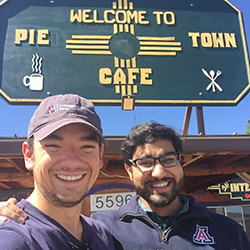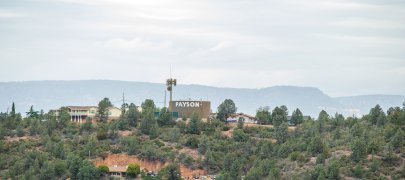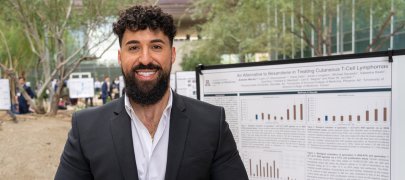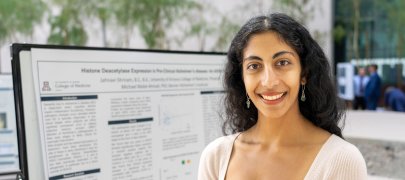A Little Slice of Americana
"The desert is an ecstatic critique of culture, an ecstatic form of disappearance."
— French Philosopher Jean Baudrillard
In Arizona, as in the rest of the United States, there is a chronic shortage of rural physicians. So much so, that in the mid-1990’s the Arizona Legislature passed a statute requiring Arizona medical students to complete a rural education experience. This led the University of Arizona College of Medicine – Phoenix to create the Rural Health Professions Program (RHPP) and the Rural Health Certificate of Distinction. Through these programs, students provide care to underserved populations, and some also seize the moment to have an adventure in an unfamiliar place.
 For two third-year students Michael Wasserman and Omar Hussain (pictured left), that opportunity was one that would not go wasted.
For two third-year students Michael Wasserman and Omar Hussain (pictured left), that opportunity was one that would not go wasted.
Wasserman, who was on rotation in Silver City, New Mexico, and Hussain, who was in Fort Defiance, Arizona, had heard of a place called Pie Town, New Mexico. Not far from either of them, a short three-hour trip, they decided to meet up.
The town is a haven for the road warriors, who make their rounds on the highways and byways that crisscross throughout the country, cyclists and hikers trudging their way across the Continental Divide. It’s a small, sleepy kind of town, boasting a population of only 40 people, yet what it does prominently feature — and what draws in those crowds who’ve spent long hours at the wheel, clutching the handlebars or traipsing in the mountains — is, well, pies.
During their journey, Wasserman and Hussein shared a slice at two of the three restaurants that call Pie Town home. One, the Pie-O-Neer Cafe, located just off the aptly titled Pieway 60 and once even had a film made about, was packed with road trippers by noon. The other, the Pie Town Cafe, had pie so good Wasserman and Hussein thought they had, “pied and gone to heaven.”
Truly, the drive was about more than simply the potential flavor. Wasserman knew this was something special: “We definitely acknowledged how fortunate we are that this is our life right now. When I look back on medical school, these are the times I'll remember fondly.”
That sort of uniqueness is one that cannot be easily replicated, yet there is also a more pressing lesson to be learned from Pie Town. As Wasserman described, it was a place growing lost in time, a place of fading memories, a place where “the horseshoe courts have weeds growing in them and the swing set was probably stable when it was first erected, but only rust plays on it now, and the boarded-up concession stand has a hand-painted sign saying ‘Pie Fest 2009!!’ ”
Just because a person does not see places like this does not mean they do not exist. Through the RHPP, medical students at the college come to understand that, and for Wasserman and Hussain, it was illuminating in more ways than one.
“A competent rural physician can have an extraordinary impact because the level of responsibility and scope of practice is truly dictated by the physician's knowledge base and comfort level,” Wasserman said.
Outside of the greater autonomy, though, it is also crucial because the coverage gap continues to widen. According to the National Rural Health Association, it is estimated that rural areas could be short 45,000 doctors by 2020.
Seeing that firsthand cannot be understated. These areas of the country are hurting; they are in need.
“The most rewarding aspect of rotations like this is the community that we're inserted into. A rural doctor is only as good as her/his reputation, and I've had the fortunate opportunity to work with extraordinary physicians on my rural placements,” Wasserman said. The doctors in these areas are a part of these people lives. Some patients even travel tens of miles to see them. A doctor’s responsibility in such a place is magnified because they may be the only option.
Besides helping a population in desperate need of medical care, students placed in a rural setting often are exposed to more training than if they were in a large city.
 “For example, a third year medical student in the OR in a major city is lucky if they get a view of the operating table, let alone if they're allowed to scrub in,” Wasserman said. “Between the attending surgeons, fellows, residents and allied health providers, the division of labor in medicine is at the expense of medical student education.”
“For example, a third year medical student in the OR in a major city is lucky if they get a view of the operating table, let alone if they're allowed to scrub in,” Wasserman said. “Between the attending surgeons, fellows, residents and allied health providers, the division of labor in medicine is at the expense of medical student education.”
The spirit of their shared journey has inspired Wasserman to continue to hunt for these distinctive pockets of America, “I don't think I'll ever stop searching out these little slices of Southwest Americana precisely because I'm endlessly fascinated by the alien existence that rural Southwest towns carve out for themselves.”
Solving the rural health shortage, however, will not be as simple; yet perhaps as students become more aware that there are experiences like this out there to see, share and discover, the notion that they will seek out rural openings in the future may not be so “pie” in the sky.
Article by: Tom Kelly
About the College
Founded in 2007, the University of Arizona College of Medicine – Phoenix inspires and trains exemplary physicians, scientists and leaders to optimize health and health care in Arizona and beyond. By cultivating collaborative research locally and globally, the college accelerates discovery in a number of critical areas — including cancer, stroke, traumatic brain injury and cardiovascular disease. Championed as a student-centric campus, the college has graduated more than 800 physicians, all of whom received exceptional training from nine clinical partners and more than 2,700 diverse faculty members. As the anchor to the Phoenix Bioscience Core, which is projected to have an economic impact of $3.1 billion by 2025, the college prides itself on engaging with the community, fostering education, inclusion, access and advocacy.


